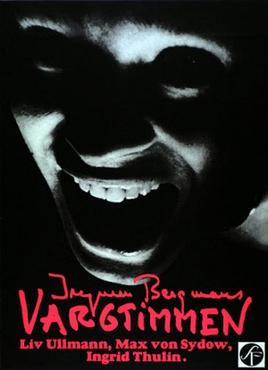Pages
▼
Monday, June 5, 2017
Hour of the Wolf (Ingmar Bergman, 1968)
Ingmar Bergman's Hour of the Wolf is unquestionably a "horror movie" -- i.e., one filled with incidents and images and narrative details aimed at shocking the viewer. It takes place on a remote island with a mysterious castle. Figures appear who may be either humans or demons. There's a scene in which a man walks up the wall and across the ceiling and one in which a woman peels off first her wig and then her face. The protagonist either murders or imagines that he has murdered a small boy. That protagonist is Johan Borg (Max von Sydow), an artist, who has come to the island with his wife, Alma (Liv Ullmann), to recover after an illness -- physical or mental, we're not told. Johan can't sleep, and Alma sits up with him at night while he tells her about the demons whose images he has sketched, so no wonder that her own mental state becomes fragile. One day, she meets an old woman who tells her that she should read Johan's diary, which he keeps under his bed. She does so, rather like Bluebeard's wife persisting in opening his castle's doors, uncovering some disturbing entries regarding his continued obsession with an old love, Veronica Vogler (Ingrid Thulin). They're invited to a dinner party at the castle by the baron (Erland Josephson), where they meet a variety of unlovely sophisticates and are entertained by a rather bizarre puppet show excerpt from Mozart's The Magic Flute (an opera that Bergman would film, in a less bizarre manner, seven years later). But the climax of the evening comes when the baroness (Gertrud Fridh) takes the Borgs to her bedroom to show off her prized possession: Johan's portrait of Veronica Vogler. From then on, it's a deep descent into madness for Johan and a desperate attempt by Alma to save both of them from self-destruction. The "creep factor" in Bergman's movies is never entirely missing, but Hour of the Wolf cranks it up higher than ever. The problem is that the creepiness is sustained almost to the point of tedium, and with a concomitant loss of credibility. The remote island setting prevents the film from grounding itself in normality, so that the action plays out on one sustained note of oppressive isolation. Hour of the Wolf has many admirers, who rightly point out that Bergman, with the considerable help of his actors and his cinematographer, Sven Nykvist, has crafted a nightmare of erotic obsession with the utmost skill. But I like to compare Hour of the Wolf to another horror movie released the same year, Roman Polanski's Rosemary's Baby, a "commercial" product aimed at a general audience, which suggests evil things going on beneath the surface of a commonplace urban setting, and ask which is the more successful: the sustained psychological oppressiveness of the Bergman film or the sinister mixture of comedy and shock of the Polanski movie?
Charles Matthews
